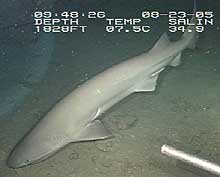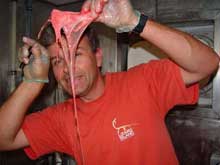Sharks & Slime
August 23, 2005
Justin Marshall, Ph.D.
Marine Biologist
Vision Touch and Hearing Research Centre
QBI, University of Queensland
Australia
Latitude: 26° 19.916' N
Longitude: 84° 45.855' W
It is not every day that you get to see an 8 foot long six-gill shark brush the top side of your submersible. Come to think of it, it is not every day you get to sit at 1800ft in a submersible at the bottom of the ocean and watch the world go by. Today therefore ranks as one of the greats in my life.
Our tasks for submersible work at the last of our dives at the lithoherm mounds off the southwest Florida shelf were to recover Dr. Frank’s hopefully-full crustacean traps, to collect animals for study, and to bring the Eye In The Sea (EITS) back with its can full of video clips of life in the deep, dark ocean. As ever with submersible research, some of this went according to plan and some did not. In fact the one significant disappointment was that the crustacean traps only worked well for catching super-slimy hagfish and, not surprisingly, the crustaceans then gave them a wide berth. Actually, even the hagfish collected in these traps will be useful for a project on what these amazing eel-like scavengers of the deep might see. This project, run by a friend and colleague of mine back in Australia (A/Prof. Shaun Collin) is a genetic study to investigate the beginnings of vision in vertebrates. Hagfish are chordates and therefore almost a vertebrate, in terms of evolution, and understanding how their visual system works will teach us a lot about our own vision. After wrestling these writhing slime-balls out of the traps, I am glad they are indeed only distantly related to most of us.
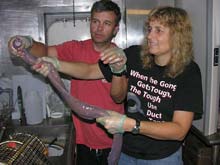
Scientists Justin Marshall and Tammy Frank holding one of the “disgusting hagfish” captured in Dr. Frank’s trap. Click image for larger view.
(top)
The dive was on a dream day of almost totally flat sea. Sinking through the blue of the top waters before reaching the inky abyss, I made polarization measurements of the water through the sphere of the sub. We humans reduce scatter and reflection at sea with the polarized sun-glasses that are a favorite among the sea-going fraternity. Many animals living in the ocean learned this trick millions of years ago but we are only just beginning to understand their methods and reasons for wanting to have polarization vision. There will be more on this in upcoming logs about our blue-water dives.
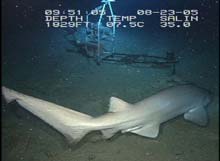
Six-gill shark swimming in for an inspection of the Eye-in-the-Sea. Click image for larger view and image credit.
Once on the muddy bottom, we used ship location capability and underwater ‘pingers’ to locate the hardware and collect the traps and their seething hagfish cargo. Safely stowed in the sub’s front basket, we turned our attention to collecting a few animals such as anemones and gorgonian corals for study at the surface. Lastly we went to get EITS and it was here we saw the shark.
EITS, the Eye-In-The-Sea, is literally this. It is a high sensitivity camera system developed by Edie Widder, the co-chief scientist of this exploration, Erika Heine-Raymond and Lee Frey to observe deep-sea life under more natural conditions than from a noisy, clanging and dazzlingly bright submersible. EITS proved itself on the last Deep Scope mission in 2004, bringing back images and video clips of many types of deep-sea beasts. One of these was a six-gill shark, and here today was another one.
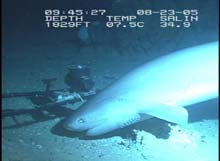
Shark attracted by the fish pieces attached to the tip of the EITS frame and in its bait cage. Click image for larger view and image credit.
We observed the shark from the sub this time, actually
nosing around the EITS before we recovered it and being slow, magnificent
and beautiful as only six-gills can. They are relaxed sharks, not like
their speedy, twitchy cousins of surface waters and this guy swam slowly
around nuzzling the bait can positioned on EITS specifically to bring in
such wonderful animals. While I was trying to be calm and scientific and
concentrate on getting good film footage of the animal from the front of
the sub, Erika was going nuts in the back. After spending years putting
together complex deep-sea sampling devices it is always good to see them
work perfectly.
![]() Watch the six-gill shark video.
Watch the six-gill shark video.
For me, every visit to the deep-sea, whether with subs or nets, brings something new. Today was my first close brush with one of the rare “charismatic megafauna” of the deep oceans and it has reinforced my desire to understand more about how this ecosystem works and how to protect it for the future. Much of my time in Australia is spent studying coral reef systems, an assemblage of life that we are rapidly destroying. It is imperative that we understand more about the deep oceans and what lives there so we can judge if the hand of man is also reaching this relatively inaccessible part of our planet.
Next year I am chief scientist on a team that will, for the first time, bring manned submersibles to Australian waters. Inevitably named Deep Downunder, the expeditions are led by Mike McDowell and Deep Ocean Quest. Both Mike and I share a passion for discovery and conservation and I hope, when we visit the deep ocean there, we will find six-gills, swimming slowly around in pristine waters.



























